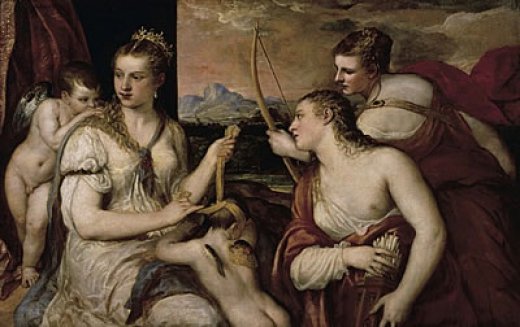The opening sees Pope Paul III grabbing look on the world, his hands-claws holding the chair on which he’s seating; it’s 1543. This is the date from which we start the 20 year journey in the oceanic activity of the greatest of painters. The last, the very last, Titian is enshrined in the atmosphere of the Pietà of the Accademia: an immense ex voto aiming at preventing the plague epidemic that was spreading in 1576, the year of the painter’s death.
Everything seems to collapse, to decompose, and then reappear in a new hallucinated vision of shattering light with 27 other pictures, perceived as ‘final’. The exhibition “The last Titian, the sensuality in painting” comes from the Kunstistorische Museum in Vienna, it’s curated by Sylvia Ferino-Pagden and Giovanna Nepi Scirè and will be open until the 20th of April. The show includes a variety of absolute and hard-to-see masterpieces as, for instance, the ‘Marsia punishment’ coming from Kromeriz, in the Check Republic. Thanks to some exceptional borrowings, insured for nearly one billion euro, this exhibition is a unique opportunity to see the works belonging to this period of Titian’s activity, here in Italy. An expositive itinerary consisting of three sections dedicated to the portraits, to the profane subjects and to the holy painting. The dressing is designed with great intuition by the architect Barbara Accordi, it’ s characterized by grey velvet-like panels that disorientate the visitor and amplify the homogeneous space of the huge hall-church enhancing the works on display. For Titian, the thirties mark a difficult key-stone in terms of language, of complex, complicated and mismanaged trading relations with Europe’s most famous courts and papacies. Among these, the delicate and long relation with Philippe II of Spain that brought him many dislikes in Venice, after his return. Moreover, he had to face the aversion of his friend, the writer Aretino that bitterly criticizes his portrait of 1945 for being “more sketched than finished”.
In 1546, he delivers two fundamental works to the pontificate, namely the “Danae”, ordered by the cardinal Alexander, and the great dialogue of “Paul and his nephews”. After that, he promises to come back to Venice where, instead, he will never return, as Augusto Gentilini notes in his intervention in the catalogue: “In Rome, he had received board, lodging and many honours but apparently the pictures he had delivered were never paid for”. Moreover, one should note that in Venice, in 1548, the great subversive charge of Tintoretto explodes with his extreme painting style. An other supreme artist of this period is Paolo Veronese. “Where was Titian? He was in Augsburg, of course, flattering Charles V, his family and the influential figures of the empire with portraits and devotions” as Gentilini sarcastically notes. One could hardly imagine the aversions that arose when he came back, that autumn. For the supreme painter that had been celebrated and glorified abroad, it must have been very hard to face the new generation of artists, even though he could still count on the support of the customs class. It’s interesting to follow the development of the changing process in Titian’s activity, starting from an acknowledgement of his situation, the need for a change and finally his last works. In an essay published by Neri Pozza, in the book Titian and Venice, Rodolfo Pallucchini investigates the long transition process involving Titian’s pictorial style after the Mannerism ‘fracture’. In particular, Pallucchini analyses two pictures “The sacred love and the profane love” dating back to 1515 and “Tarquinius and Lucrezia” of 1570. From the fifties onwards, Titian avoids the Renaissance characterizing traits adopting a more immediate form of mark and spreading. His technique becomes exasperated, every naturalistic element is eliminated.
In a passage of his book, “Mines of Venetian painting”, Boschini is particularly explicit about this: “Titian creates a more immediate technique, characterized by a concrete pulse, in which every idea of space is eliminated, what’s left is the hallucinated transfiguration of a single moment of human passion, of a power as great as the one evoked in Shakespeare’s work. The “last fires” are years characterized by an extraordinary return to Titian’s more intimate and dramatic production. The painter’s ideology overcomes painting to hide inside the darkest part of human spiritual affliction. _ In the final part of his intervention, Gentilini describes a forlorn Titian, alone in his empty shop, painting for himself or for a virtual public: “In the face of the others’ works, filling schools and churches, he must have understood that the harmonic language he would use in his best times, though developed and updated, could not any longer hold (nearly) anybody’s interest, most of all, his own; still, Philippe of Spain remains his one supporter. _ Every now and then, from Spain, Germany but never from Venice, suggestions about new stories or reproduction of old ones, reach his ears but he just doesn’t consider them. He makes a try: prepares, sketches, starts then he turn the canvas against the wall and waits; he never concludes a work, though often he believes he has finished it, anyway. He’s searching for an essential language that doesn’t exist yet- that hasn’t even been imagined yet- to maintain a program coherence and cognitive dignity to the last stories and poetries”.



